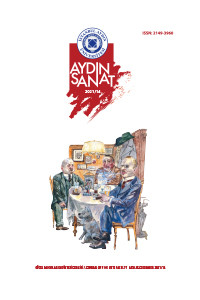Abstract
George Grozs ve Otto Dix savaş dönemi ressamlarıdır. Savaşı yaşan sanatçıların eserlerinde problematik temalı düşünceler yoğunluktadır. Eserlerinde toplumsal problemleri ele alan karşıt söylemler yer almaktadır. Araştırmanın amacı; George Grozs ve Otto Dix’in resimlerinde anti sempatik ve karşıt yaklaşımların neler olduğunu ortaya çıkarmaktır. Ayrıca Rudolf Schlichter ve Karl Hubbuch gibi çağdaşlarının eser analizlerine yer verilerek; George Grozs ve Otto Dix’in eserleriyle karşılaştırması yapılmıştır. Dolayısıyla aynı süreci yaşayan sanatçıların eserlerinde üslup, düşünce ve eleştiri gibi kavramların nasıl uygulandığına ilişkin tespitler yapılmıştır. Böylece ele alınan sanatçıların eser analizleri yapılmasıyla birlikte; bu kavramların bir sanatçı için neden önemli olduğuna ve altında yatan nedenlerin neler olacağına ilişkin açıklık getirileceği umulmaktadır. Aynı zamanda George Grozs ve Otto Dix’in diğer sanatçıların eserleriyle olan benzerlikleri ve farklı yanlarının ortaya çıkarılacağı düşünülmektedir. Araştırmanın problemleri şu şekildedir: George Grozs ve Otto Dix’in eserlerinde anti sempatik ve karşıt yaklaşımların öne çıkmasındaki gerekçeler nelerdir? Savaşı yaşayan toplumların sanatında ortak özellikler nelerdir? George Grozs’un eserlerinde mizah neden önemlidir? Yeni Nesnellik akımını Dışavurumculuktan ayıran özellikler nelerdir? Yeni Nesnellik; bir toplumun ve düzenin eleştirisi midir? George Grozs ve Otto Dix için nesnellik neden önemli bir kavramdır “Berlin Friedrichstrasse” ve “Der Stammtisch eserleri bir toplumun eleştirisi olarak neyi ifade etmektedir? Bu araştırmanın önemi; savaş dönemi sanatçılarının eserlerinde öne çıkan ifade, anlam ve biçim bozma gibi tekniklerin güncel sanatta ne gibi arayışlara sebep olduğunun farkına varmaktır.
References
- Antmen, A. (2008). Sanatçılardan Yazılar ve Açıklamalarla 20. Yüzyıl Batı Sanatında Akımlar (2.Baskı). İstanbul: Sel Yayıncılık.
- Demirel, M. R. (2017). Weimar Cumhuriyeti Kültür Politikaları ve Altın Yirmili Yıllar. Akademik Sanat; Sanat, Tasarım ve Bilim Dergisi, Cilt 2, Sayı 4, 36.
- Şahin, A. N. E. ve Kayalıoğlu, S. (2016). I. Dünya Savaşı’nın Avrupa Resim Sanatına Etkileri. Gazi Akademik Bakış, Cilt 10, Sayı 19, 201.
- Uçan, B. (2018). George Grosz Eserleri Üzerinden Dada ve Mizah Bağıntısı. Yıldız Journal of Art and Design, Cilt 5, Sayı 1, 28.
- Üner, A. (2014). Kavramsal Açıdan Nesnellik. MAVİ ATLAS GŞÜ Edebiyat Fakültesi Dergisi, Bahar, Sayı 2, 58.
- https://artwizard.eu/otto-dix,-masterpiece-collection-for-sale-at-sotheby%E2%80%99s-this-week-ar-96. Erişim Tarihi: 7 Haziran 2021.
- https://www.britannica.com/biography/George-Grosz. Erişim Tarihi: 10 Haziran 2021.
- https://www.britannica.com/biography/Otto-Dix. Erişim Tarihi: 11 Haziran 2021.
- https://www.museothyssen.org/en/collection/artists/grosz-george/der-stammtisch. Erişim Tarihi: 9 Haziran 2021.
- https://www.nationalgalleries.org/art-and-artists/artists/karl-hubbuch. Erişim Tarihi: 9 Haziran 2021.
- https://www.tate.org.uk/art/lists/five-things-know-otto-dix. Erişim Tarihi: 9 Haziran 2021.
Abstract
George Grosz and Otto Dix are painters from the war era. Thoughts with problematic themes are intensely found in artists who lived through the war. There are opposing statements that approach societal problems in their their works. The aim of this research is to expose what the anti-sympathetic and opposing approaches are in the paintings by George Grosz and Otto Dix. In addition, including an analysis of the works by Rudolf Schlichter and Karl Hubbuch, a comparison has been made with the works of George Grosz and Otto Dix. Therefore, how concepts such as style, thoughts, and criticism in artists who have experienced the same process have been determined. Thus, by carrying out an analysis of the works for the artists who were approached; it is expected that it will clarify why these concepts are important for the artist and what the underlying reasons might be. At the same time, it is thought that this will expose the similarities and the differences between the works of other artists, and George Grosz and Otto Dix. The problems in the study are as follows: what are the reasons anti-sympathetic and opposing approaches are prominent in the works by George Grosz and Otto Dix? What common characteristics exist in the societies who live through war? Why is humour important in George Grosz’s works? What characteristics separate the New Objectivity and Expressionism movements? Is New Objectivity a criticism of a society and order? Why is objectivity an important concept for George Grosz and Otto Dix? What do the works “Berlin Friedrichstrasse” and “Der Stammtisch” express as a critism of society? The importance of this study is to recognize what pursuits the techniques such as expression, meaning, and obstruction of form, which were prominent in war era artists’ works, led to in contemporary art.
References
- Antmen, A. (2008). Sanatçılardan Yazılar ve Açıklamalarla 20. Yüzyıl Batı Sanatında Akımlar (2.Baskı). İstanbul: Sel Yayıncılık.
- Demirel, M. R. (2017). Weimar Cumhuriyeti Kültür Politikaları ve Altın Yirmili Yıllar. Akademik Sanat; Sanat, Tasarım ve Bilim Dergisi, Cilt 2, Sayı 4, 36.
- Şahin, A. N. E. ve Kayalıoğlu, S. (2016). I. Dünya Savaşı’nın Avrupa Resim Sanatına Etkileri. Gazi Akademik Bakış, Cilt 10, Sayı 19, 201.
- Uçan, B. (2018). George Grosz Eserleri Üzerinden Dada ve Mizah Bağıntısı. Yıldız Journal of Art and Design, Cilt 5, Sayı 1, 28.
- Üner, A. (2014). Kavramsal Açıdan Nesnellik. MAVİ ATLAS GŞÜ Edebiyat Fakültesi Dergisi, Bahar, Sayı 2, 58.
- https://artwizard.eu/otto-dix,-masterpiece-collection-for-sale-at-sotheby%E2%80%99s-this-week-ar-96. Erişim Tarihi: 7 Haziran 2021.
- https://www.britannica.com/biography/George-Grosz. Erişim Tarihi: 10 Haziran 2021.
- https://www.britannica.com/biography/Otto-Dix. Erişim Tarihi: 11 Haziran 2021.
- https://www.museothyssen.org/en/collection/artists/grosz-george/der-stammtisch. Erişim Tarihi: 9 Haziran 2021.
- https://www.nationalgalleries.org/art-and-artists/artists/karl-hubbuch. Erişim Tarihi: 9 Haziran 2021.
- https://www.tate.org.uk/art/lists/five-things-know-otto-dix. Erişim Tarihi: 9 Haziran 2021.
Details
| Primary Language | Turkish |
|---|---|
| Journal Section | Research Articles (Double blind peer reviewed and open to be indexed) |
| Authors | |
| Publication Date | December 28, 2021 |
| Submission Date | August 13, 2021 |
| Published in Issue | Year 2021 Volume: 7 Issue: 14 |
All site content, except where otherwise noted, is licensed under a Creative Common Attribution Licence. (CC-BY-NC 4.0)



